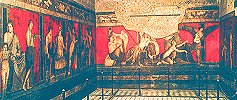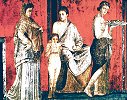Villa of Mysteries, Pompeii |
Villa of Mysteries, Pompeii |
As the Romans spread their empire, they had adopted much of Greek culture, including its myths and religious practices. The Roman pantheon and religious system came to include more and more gods and became increasingly complicated, so Romans compensated in various ways. One way was to centralize official civil religion through the cult of emperor worship. Another way was through more personal forms of religious devotion known as "mystery religions."
Already in ancient Greece, some people had found personal hope and comfort through secret rituals devoted to a single god, such as Dionysos. Associated with seasonal death and rebirth, he seemed to offer devotees hope of sharing in his rebirth. In the last few centuries of the Roman empire many such mystery religions sprang up, offering their initiates secret knowledge, rites, and the promise of mystic union with divinity – usually as a complement to the official religion rather than a challenge to it.
Evidence of one such mystery religion was discovered in the archeological ruins of Pompeii, in southern Italy. The sudden volcanic eruption that engulfed and destroyed the seaside villa in 79 CE left exceptionally well-preserved evidence of the life, art, and culture of well-to-do Romans.
|
Villa of Mysteries Pompeii, Italy, before 79 CE |
|
 |
Although these paintings are in a private home, they are the precursors of large frescoes which would later adorn the walls of palaces and Christian churches. Pompeiian homes typically had wall paintings, often of landscape or architecture, perhaps because rooms often lacked windows. These paintings in the Villa of Mysteries, however, form a sequence, taking up the whole space of the room, and they clearly depict a religious ritual. The mistress of the house was probably a devotee of the Dionysiac cult and this room might have been used for the actual rites. |
 |
The wall depicts twenty-nine almost life-size figures as they take part in the ritual. Here, a woman listens to a naked boy reading the liturgy of the ritual. The initiation process probably ended with a mystical marriage to the god Dionysos (or Bacchus), the god of wine and fertility. This "marriage" was thought to insure the initiate's fertility as an actual wife. |
 |
Satyrs are associated with Dionysos (note their pointed ears) and goats are one of his sacred animals. The satyr plays the pipes while the satyress gives suck to a goat. The only adult males allowed in the ritual are the mythical satyrs and Dionysos himself. |
 |
The culmination of the initiate's experience was the ordeal of beating, a kind of symbolic purification, perhaps to expel the demon of sterility. After this she could be symbolically married to Dionysos. |
Click here for more on the Villa of Mysteries. |
All images marked MAS were photographed on location by Mary Ann Sullivan. All other images were scanned from other sources or downloaded from the World Wide Web; they are posted on this password-protected site for educational purposes, at Bluffton College only, under the "fair use" clause of U.S. copyright law.